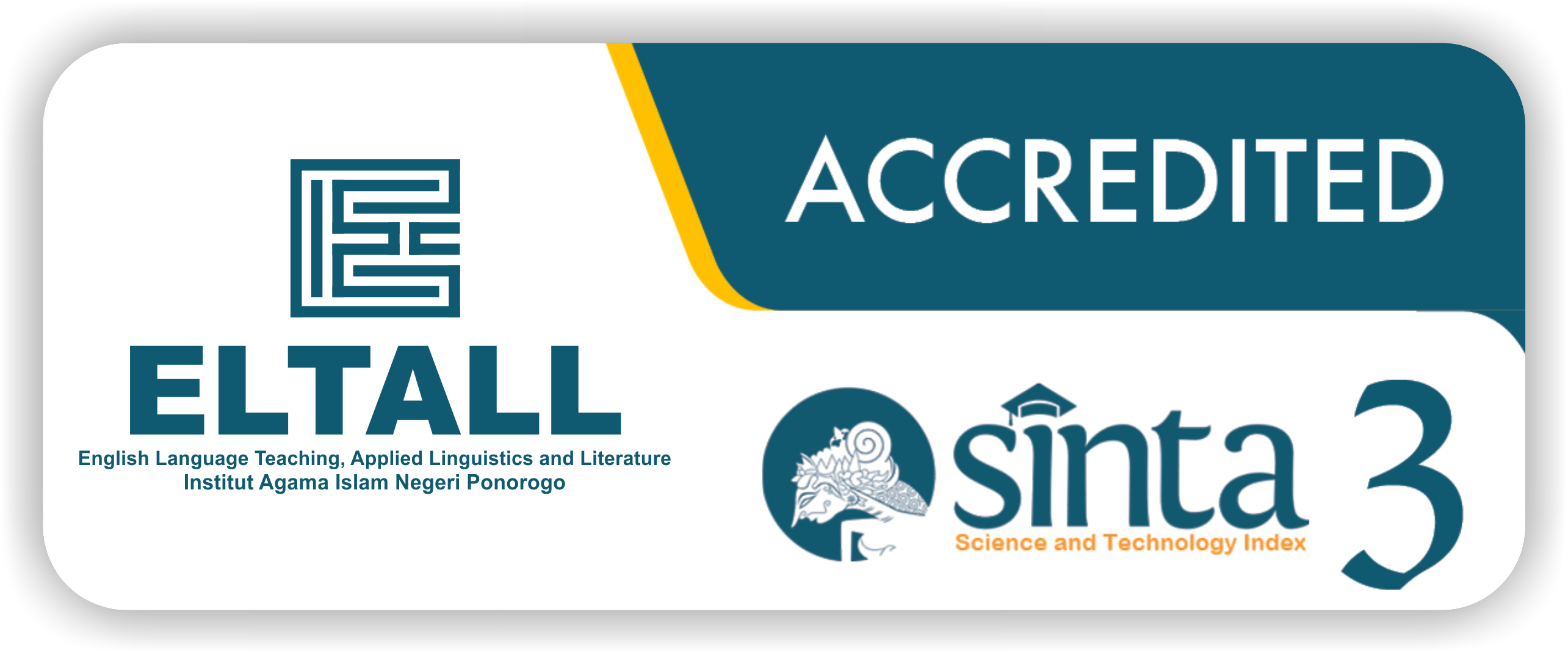Metaphorical Expression used in Poetry in book "The Everyday Poet" by Deborah Alma
DOI:
https://doi.org/10.21154/eltall.v4i1.5860Keywords:
Metaphor, poetry, The Everyday PoetAbstract
Poetry is characterized as a kind of literature or creative writing that uses a variety of poetic approaches to stimulate the reader's emotions and imagination. This study focuses on the metaphorical expression used in poetry in the book "The Everyday Poet" by Deborah Alma. The objectives of this study are to determine the types of metaphors reflected in Deborah Alma’s poetry book "The Everyday Poet," to find out the most common types of metaphors used, and to explain the meaning of the metaphors contained in the poems. The methodology used in this study is descriptive qualitative research. The data were obtained through library research and a variety of literature to present a descriptive issue. The result of this study showed that there are twelve metaphors in the book "The Everyday Poet." There are six anthropomorphic metaphors, one animal metaphor, two abstract to concrete metaphors, and three synesthetic metaphors, and based on the data, the most commonly used metaphor is anthropomorphic metaphor, which has six lines in the book "The Everyday Poet" by Debora Alma.
References
Dirgeyasa, I. W. (2017). The Effort to Increase the Students’Achievement in Poetry. Advances in Language and Literary Studies, volume 8, 105-110.
Meyer, J. (1997). What Is Literature? A Definition Based on Prototypes. Work Papers of the Summer Institute of Linguistics, University of North Dakota Session 1997 Volume 41, 41.
Ketaren, S. V., & Pakpahan, E. M. (2021). METAPHORICAL EXPRESSION USED IN POETRY IN ENGLISH TEXTBOOK ENTITLED “PATHWAY TO ENGLSIH”. PROJECT (Professional Journal of English Education), Vol. 4 No. 3, 469-479.
Hutauruk, B. S. (2019). THE USE OF FIGURATIVE LANGUAGES ON THE STUDENTS”Ÿ POETRY SEMESTER V AT FKIP UNIVERSITAS HKBP NOMMENSEN. Journal of English Language and Culture, Vol. 9 (no. 2), 128-137.
Rahman, I. A. (2018). Metaphor Analysis on Students’English Poems. English Language in Focus (ELIF), 1 (1), 1-8.
Marpaung, M. S., & Ramadhan. (2021). The Rhyme of Joyful Feeling in “To Autumn” By John Keats. Acuity: Journal of English Language Pedagogy, Literature, and Culture, Vol. 6 No. 1, 63-79.
Sandelowski, M. (2000). Whatever Happened to Qualitative Description? Research in Nursing & Health, 23, 334-340.
Lan, C & Yin, Z.(2020). A cognitive approach to the conceptual metaphors in Shi Jing (The Book of Poetry). De Gruyter Mouton, 14, 173-195.
Parera, J.D. (2004). Teori Semantik. Jakarta: Erlangga.
Rasse, C., Onysko, A., & Citron, F. M. (2020). Conceptual metaphors in poetry interpretation: a psycholinguistic approach. Language and Cognition, 12, 310-342.
Nur, M. R., & Miranti, R. R. (2018). The Analysis of Figurative Language Used in "Still I Rise" Poem by Maya Angelou. International Summit on Science Technology and Humanity (ISETH 2018), 19-29.
Khairunisa, N., Dirgeyasa, I. W., & Putri, C. A. (2020). FIGURATIVE LANGUAGE IN AMIR HAMZAH’S POEMS. Linguistica, Vol. 9, No. 1, 258-266.
Downloads
Published
Issue
Section
License
All articles published in ELTALL (English Language Teaching, Applied Linguistics, and Literature Journal) are licensed under the Creative Commons Attribution-NonCommercial 4.0 International License (CC BY-NC 4.0).
Under this license, authors and readers are free to:
- Share. copy and redistribute the material in any medium or format
- Adapt. remix, transform, and build upon the material
Under the following terms:
- Attribution. You must give appropriate credit, provide a link to the license, and indicate if changes were made. You may do so in any reasonable manner but not in any way that suggests the licensor endorses you or your use.
- Non-Commercial. You may not use the material for commercial purposes.
Notices:
- The licensor cannot revoke these freedoms as long as you follow the license terms.
- No additional restrictions. You may not apply legal terms or technological measures that legally restrict others from doing anything the license permits.
For the full legal code of the license, please visit: https://creativecommons.org/licenses/by-nc/4.0/













